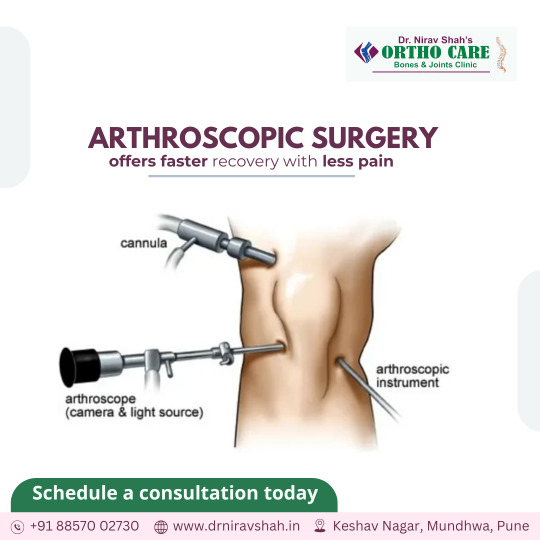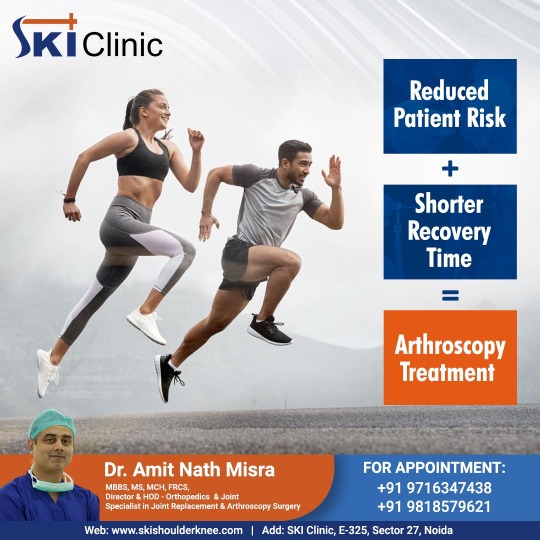#ArthroscopicSurgery
Explore tagged Tumblr posts
Text
Beyond the Tear: Arthroscopic Repair for Multifactorial Shoulder Pathologies
Best Orthopedic Hospital in Hyderabad, Telangana, India – PACE Hospitals successfully performed arthroscopic procedures to treat rotator cuff damage, biceps tendonitis, and frozen shoulder in a 66-year-old male patient. This comprehensive surgical intervention effectively restored his mobility and functional capacity, enabling him to return to his daily activities with ease.
Chief Complaints
The patient, a 66-year-old male, presented to the Orthopedics Department of PACE Hospitals, Hitech City, Hyderabad, with persistent right shoulder pain that significantly impaired his ability to perform overhead activities. His symptoms included severe discomfort and a markedly reduced range of motion, which progressively worsened and began interfering with routine tasks.

#ShoulderSurgery#Arthroscopy#RotatorCuffRepair#FrozenShoulder#BicepsTendonitis#OrthopedicCare#PACEHospitals#ShoulderHealth#MinimallyInvasiveSurgery#JointRecovery#MobilityMatters#SportsInjuryRecovery#OrthoExperts#ShoulderPainRelief#ArthroscopicSurgery#MultifactorialPathologies#ReturnToMovement
0 notes
Text
Best Orthopaedic Doctor in Shastri Nagar Jaipur
Get Back to Doing What You Love – Expert Orthopedic Care by Dr. Shubham Agarwal
Life is meant to be active and pain-free, but joint pain and injuries can put a pause on the things you love. Whether it’s playing your favorite sport, going for a walk, or simply moving with ease, you deserve to feel your best. That’s where Dr. Shubham Agarwal, the Best Orthopaedic Doctor in Shastri Nagar, Jaipur, comes in. With expert care and advanced treatments, he helps people regain mobility and get back to living life to the fullest.
Personalized Orthopedic Care for a Pain-Free Life Dr. Shubham Agarwal believes that no two patients are the same, and neither should their treatment plans be. With years of experience and a compassionate approach, he offers a range of specialized orthopedic treatments designed to help you heal and move better.
Sports Injury Treatment Injuries happen, whether you’re an athlete or just enjoy staying active. From ligament tears to fractures, Dr. Agarwal provides cutting-edge treatments to help you recover quickly and safely, so you can get back to doing what you love.
Total Knee Replacement Knee pain shouldn’t stop you from enjoying life. If arthritis or an old injury is making movement difficult, total knee replacement can be a game-changer. Dr. Agarwal uses advanced techniques to ensure a smooth surgery and a fast, effective recovery.
Hip Replacement Struggling with hip pain? Whether it’s due to aging, injury, or wear and tear, hip replacement surgery can restore your mobility and bring relief. Dr. Agarwal specializes in both partial and total hip replacements, ensuring you receive the best care possible.
Arthroscopic Surgery For those dealing with joint pain and mobility issues, arthroscopic surgery offers a minimally invasive solution. With tiny incisions and advanced technology, Dr. Agarwal can diagnose and treat joint problems with minimal downtime, helping you heal faster.
Why Choose Dr. Shubham Agarwal?
A patient-first approach with personalized care.
Expertise in advanced orthopedic treatments and surgeries.
Minimally invasive techniques for quicker recovery.
Dedicated to helping you move pain-free and live better.
If joint pain is keeping you from enjoying life, Dr. Shubham Agarwal, the Best Orthopaedic Doctor in Shastri Nagar, Jaipur, is here to help. Take the first step toward pain-free movement—book a consultation today!
For more details, visit Dr. Shubham Ortho & Sports Injury Centre and start your journey toward recovery!
#OrthopedicCare#JointPainRelief#SportsInjuryRecovery#KneeReplacement#HipReplacement#ArthroscopicSurgery#BestOrthopedicDoctor#JaipurHealthcare
0 notes
Text

🔰 JOCR Article of the Day:
Arthroscopic Treatment of Isolated Tophaceous Gout of the Knee: A Rare Case Report
🔶 Read Free Full text: https://jocr.co.in/wp/2025/03/01/arthroscopic-treatment-of-isolated-tophaceous-gout-of-the-knee-a-rare-case-report/
✍️ Authored by- Hitarth Gathani , Sagar Jawale , Sitanshu Shekhar Samantaray , Naved Ansari , Aravind Chanal , Rishabh Jaiswal
✅ JOCR Now accepting Original Articles and Case series too– https://www.jocr.co.in/wp/submit-article/
🔆 JOCR Indexed with Pubmed
#JOCR#OrthoCaseReport#KneeSurgery#Arthroscopy#Gout#TophaceousGout#OrthoJournal#Orthopaedics#OrthoResearch#MedicalCase#SurgeonsLife#OrthopedicSurgeon#KneePain#ArthroscopicSurgery#OrthoEducation#PubMedIndexed
0 notes
Text
Effective Treatment for Parrot Beak Tear Meniscus in Manchester
A parrot beak tear meniscus can cause severe knee pain and mobility issues. If left untreated, it may lead to long-term complications. Learn how knee arthroscopic surgery in Manchester offers a minimally invasive solution to relieve pain and restore knee function. Discover expert treatment options at The Knee Clinic Manchester and regain mobility today.
#MeniscusTear#KneeSurgery#ParrotBeakTear#ArthroscopicSurgery#KneePain#ManchesterHealthcare#SportsInjury#JointHealth#KneeSurgeon
0 notes
Text
Benefits of Arthroscopic Surgery for Sports Injuries

Sports injuries can be frustrating, especially for athletes eager to return to their routines. Fortunately, advancements in medical technology have made recovery faster and less invasive through arthroscopic surgery. If you’re considering arthroscopic treatment in Trivandrum, understanding the benefits of this procedure can help you make an informed decision.
Effective for Various Joint Injuries
Arthroscopy is commonly used for treating injuries to the shoulder, knee, ankle, and wrist — perfect for active individuals dealing with ligament tears, cartilage damage, or persistent joint pain.
If you’re struggling with a sports injury and seeking expert care, arthroscopic surgery in Trivandrum could be the solution to get you moving pain-free again!
#ArthroscopicSurgery#SportsInjuryRecovery#ShoulderArthroscopy#TrivandrumHealthcare#OrthopedicCare#AthleteRecovery#SportsMedicine#JointHealth#JointSolution
1 note
·
View note
Text

Why choose Arthroscopic Surgery?
✅ Small Incision ✅ Faster Healing ✅ Quick Recovery ✅ Reduced Hospital Stay
Get back to doing what you love without the long wait!
Book your appointment today: WhatsApp: +91 9289084372 Visit: www.drvaibhavjain.com
1 note
·
View note
Text

Minimally Invasive Arthroscopic Surgery
Minimally Invasive Arthroscopic Surgery for Joint Health
Experience precision care and faster recovery with minimally invasive arthroscopic surgery. Advanced techniques for accurate diagnosis and treatment of joint problems, ensuring quicker healing and minimal discomfort. Book your appointment now! The Benefits of Minimally Invasive Arthroscopic SurgeryArthroscopic surgery has revolutionized the way joint problems are treated. This minimally invasive technique involves using a tiny camera and specialized tools to diagnose and repair joint issues, such as ligament tears, cartilage damage, and joint inflammation.
Key benefits include:
Smaller Incisions: Minimal scarring and reduced tissue damage.
Faster Recovery: Patients typically experience quicker healing and shorter hospital stays.
Less Pain: Reduced post-surgical discomfort compared to traditional open surgery.
Arthroscopic surgery is a preferred solution for athletes, active individuals, and those seeking effective relief from joint pain. If joint discomfort or limited movement is holding you back, consult an expert to explore the benefits of this advanced surgical option. Take the first step towards pain-free movement today!
#ArthroscopicSurgery#MinimallyInvasive#JointHealth#FasterRecovery#OrthopedicCare#SportsInjuries#SurgeryOptions
0 notes
Text
Dr. Yogesh Patil – Best Orthopedic Surgeon in Thane for Arthroscopic Surgery.

Dr. Yogesh Patil, a renowned orthopedic surgeon in Thane, specializes in arthroscopic surgery, offering advanced treatments for joint, knee, and hip issues. Known as the best orthopedic surgeon in Thane and a trusted knee replacement surgeon in Thane, Dr. Patil provides minimally invasive solutions for faster recovery and optimal outcomes.
With expertise in joint repair, knee and hip replacement, and arthroscopy, he is regarded as the top orthopedic surgeon in Thane. Patients seeking the best arthroscopy doctor in Thane trust Dr. Patil for his precision, care, and innovative techniques in orthopedic care.
Experience exceptional treatment and regain mobility with Dr. Yogesh Patil. Book your consultation today!
#DrYogeshPatil#OrthopedicSurgeonInThane#BestOrthopedicSurgeonThane#ArthroscopicSurgery#KneeReplacementSurgeonThane#HipReplacementSpecialist#BestArthroscopyDoctorThane#TopOrthopedicSurgeonThane#JointCareThane
0 notes
Text

Arthroscopic Surgery: Faster Recovery with Minimal Pain
Experience minimally invasive surgery with arthroscopy! This advanced procedure ensures quicker recovery, less pain, and better results. Get back to your active lifestyle faster than ever. Schedule your consultation now!
Arthroscopic surgery is a revolutionary procedure for treating joint issues. Unlike traditional open surgeries, this minimally invasive technique uses tiny instruments and a camera to repair damaged joints. The benefits include reduced pain, minimal scarring, and faster recovery times. Whether you’re dealing with knee, shoulder, or other joint problems, arthroscopy could be the solution for you. Restore mobility and live pain-free with the latest in medical technology!
0 notes
Text
Orthomed is the Advanced Arthroscopic PCL Rehab in Chennai

Why Orthomed is the Advanced Arthroscopic ACL Rehab Center in Chennai
Orthomed Hospital stands out as a premier destination for Arthroscopic ACL (Anterior Cruciate Ligament) Rehabilitation in Chennai. Combining state-of-the-art technology, personalized treatment plans, and expert orthopedic care, Orthomed ensures a seamless recovery journey for patients suffering from ACL injuries.
Expertise in Arthroscopic Surgery
At Orthomed, our team of experienced orthopedic surgeons specializes in minimally invasive arthroscopic procedures. This advanced technique allows for precise diagnosis and treatment of ACL injuries with minimal disruption to surrounding tissues, resulting in faster recovery times and reduced post-operative complications.
Comprehensive Rehab Programs
Rehabilitation is a critical component of ACL recovery, and Orthomed offers a holistic rehab program tailored to each patient's needs. Our multidisciplinary approach integrates:
Physiotherapy: Customized exercises to restore joint mobility, improve muscle strength, and rebuild stability.
Pain Management: Advanced techniques to manage post-surgical pain and ensure patient comfort.
Nutritional Guidance: Diet plans designed to accelerate healing and support muscle regeneration.
State-of-the-Art Facilities
Orthomed is equipped with the latest medical technology, including advanced imaging systems for precise diagnostics and real-time progress tracking. Our modern physiotherapy units feature cutting-edge equipment, helping patients regain their strength and mobility effectively.
Patient-Centric Care
What sets Orthomed apart is our commitment to patient-centered care. From the initial consultation to the final stages of rehabilitation, our specialists work closely with patients, providing support at every step. We ensure that every treatment plan is aligned with the patient’s lifestyle and goals, whether it's returning to sports or achieving everyday functionality.
Specialized Programs for Athletes
For athletes, an ACL injury can be career-threatening. At Orthomed, we offer specialized programs to help athletes recover safely and regain peak performance levels. Our sports medicine experts focus on injury prevention strategies, ensuring long-term joint health.
Why Choose Orthomed for ACL Rehab?
Expertise in minimally invasive arthroscopic procedures.
Comprehensive rehabilitation tailored to individual needs.
Access to a multidisciplinary team of orthopedic surgeons, physiotherapists, and sports medicine specialists.
Proven track record of successful recoveries and satisfied patients.
Compassionate care that prioritizes patient well-being.
Recovering from an ACL injury requires more than just surgery—it demands precise, consistent care. At Orthomed Hospital, we combine advanced medical technology with a compassionate approach to help patients regain their active lives. Trust Orthomed to deliver the best Arthroscopic ACL Rehab in Chennai for a faster, safer recovery.
📞 Contact Number: +91 99400 99992 📧 Email: [email protected] 🌍 Website: orthomedhospital.com
0 notes
Text
#ArthroscopicSurgery#LigamentSurgery#KneeInjury#SportsMedicine#OrthopedicCare#LucknowHealthcare#MinimallyInvasive#FasterRecovery#SportsInjury#OrthopedicSpecialist#LigamentRepair#InjuryRecovery#PhysicalTherapy#PainRelief#HealthCare
0 notes
Text
Best Arthroscopic Surgeon Delhi – AOSM
Find the best arthroscopic surgeon in Delhi at AOSM. Expert in minimally invasive joint surgery for knees, shoulders, and more. Book your consultation today!
0 notes
Text
orthopedic surgeon doctor in murlipura
Dr. Shubham Agarwal – Expert Orthopedic Surgeon in Murlipura
Struggling with shoulder pain or frozen shoulder? Don’t let stiffness or discomfort hold you back! Dr. Shubham Agarwal specializes in advanced, minimally invasive treatments to help you move pain-free.
Book your consultation today!
📍 Dr. Shubham Ortho & Sports Injury Centre, Jaipur
#DrShubhamAgarwal#OrthopedicSurgeon#OrthopedicDoctor#Murlipura#ShoulderPain#FrozenShoulder#ShoulderInjury#ArthroscopicSurgery#PainRelief#SportsInjury#MovePainFree
0 notes
Text

🔰Knee ArthroScopy Video on demand
🔆THE KNEE ARTHROSCOPY WORKSHOP 2023
🔆 Diagnostic Knee Scopy & BTB Harvest
🔆Speaker :Dr Vikram Sapre
🔆Click here to watch :http://tinyurl.com/OrthoTV-KNEE-ARTHROSCOPY-735
▶️ Media Partner: OrthoTV
📺 Join OrthoTV - https://linktr.ee/OrthoTV
#KneeArthroscopy#Orthopedics#MedicalEducation#ArthroscopicSurgery#KneeSurgery#OrthoTV#KneeArthroscopyWorkshop#MedicalVideo#DiagnosticKneeScopy#BTBHarvest#VikramSapre#MedicalTraining
0 notes
Text

Reduced Patient Risk + Shorter Recovery Time = Arthroscopy Treatment Visit Us: https://skishoulderknee.com/total-hip-replacement.php Our Social Media Facebook: https://www.facebook.com/dramitnathortho Twitter: https://twitter.com/DrAmitNath Linkedin: https://www.linkedin.com/in/dr-amit-nath-misra-b601a4241/
#jointreplacement#Totalhipreplacement#jointhealth#dramitnathmisra#hipreplacement#HipReplacement#Arthroscopy#ReducedPatientRisk#ShorterRecoveryTime#MinimallyInvasive#OrthopedicProcedure#JointHealth#OrthopedicSurgery#FasterRecovery#PainRelief#SurgicalInnovation#ArthroscopicSurgery#OrthoCare#JointRecovery#HealthcareAdvancements#SurgeryBenefits#OrthopedicAdvances#RapidRecovery#OrthoTreatment#ArthroCare
0 notes
Text
Shoulder Arthroscopy
Shoulder joint accounts for a large proportion of joint problems, since it is the most mobile joint in the body with a complex anatomy. In places like Nagpur, Amravati, Chhindwara, Seoni, Jabalpur etc thousands of people every year go to a doctor’s clinic like London Orthopaedic Clinic, Dhantoli, Nagpur for a shoulder sprain, strain, dislocation or other shoulder problem.

The shoulder joint is prone to injury since it is very mobile. Frequent overhead movements and injury or trauma can damage the tissues inside the shoulder. This can cause pain, tenderness, weakness, instability, and limitation of movement in the shoulder joint. The pain can radiate down into the arm of up in the neck area. Although symptoms, physical examination, and different types of X-rays, Ultrasound and MRI scans and related studies can tell us a great deal about the nature of the problem, we often need to use shoulder arthroscopy to determine more precisely what is wrong and at the same time treatment can also be done arthroscopically. Arthroscopy is keyhole surgery of the shoulder joint.Read more https://londonorthopaedicclinicngp.com/shoulder-arthroscopy/
0 notes